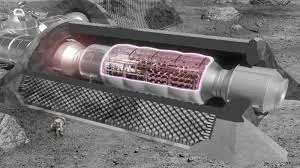
Could a Robotic Arm Greenhouse Revolutionize Food Supply for Future Lunar Astronauts?
2024-09-15
Introduction
As the prospect of continuous human habitation on the Moon approaches, various space-faring nations are aligning their goals for sustainable living in this extraterrestrial environment. One of the most pressing challenges in achieving this aims to address food supply logistics. Shipping food from Earth will soon become impractically expensive, because of both the monetary costs and limited launch opportunities. In a groundbreaking effort, Germany’s aerospace agency, DLR, is developing a semi-autonomous greenhouse that can significantly contribute to feeding astronauts stationed on the lunar surface.
The Robotic Arm: EVE
This innovative project centers around the EDEN Versatile End-effector, or EVE—an advanced robotic arm designed to automate operations within the first lunar greenhouse. Unveiled at the IEEE Aerospace conference in March, EVE aims to ensure the seamless production of fresh food in a space where traditional agriculture is impossible. The EDEN LUNA greenhouse project forms the backbone of this initiative, promising to create a fully functional growing environment for lunar exploration.
Benefits of Automation in Greenhouse Management
Managing a greenhouse is notoriously labor-intensive, and astronauts can greatly benefit from assistance in these operations. When a robotic assistant, especially one that can be managed remotely from Earth, is introduced, astronauts can devote more time to essential scientific research and exploration tasks rather than maintaining crops.
Components of EVE
EVE comprises three primary components. The transport rails enable the robotic system to traverse various positions within the greenhouse, while its robotic arm can adeptly assume precise positions to carry out designated tasks. The system's end effector is capable of performing a range of functions, from pushing and pulling to picking up items. Remarkably, EVE operates on just 700 watts of power and weighs around 170 kilograms when fully integrated.
Technological Innovations
The transport system is an ingenious adaptation of commercially available technology designed for industrial automation, allowing for versatile configuration and movement based on programmed signals. The arm itself, derived from DLR’s "This Is Not an Arm" (TINA) project, boasts seven degrees of freedom for precise movement and task execution. Each of its joints is equipped with multiple electronic controllers for optimized motor control, power management, and communication. An integral camera system further enhances operation by providing visual feedback to remote operators.
EVE's End Effector: CLASH
EVE’s end effector, known as the Compliant Low-Cost Antagonistic Servo Hand (CLASH), is ingeniously designed with a thumb and two fingers that leverage force feedback sensors to grip delicate objects. This sophisticated design enables it to not only manipulate the greenhouse's contents but also interact with its environment by sensing pressure changes.
Remote Operation and Future Implications
For now, skilled human operators will be needed to control EVE’s functions; however, the operator doesn't have to be on the Moon. The robotic arm can be managed from Earth or the Lunar Gateway, a proposed orbital station, allowing for expert oversight even when no astronauts are present on the lunar surface. As missions evolve, the continuous operation of systems like EVE will be crucial during the Moon's colonization phases, especially considering periods where human presence will be absent.
Future Testing and Conclusion
The DLR is committed to advancing the EDEN LUNA greenhouse and its robotic assistant, EVE. A full integration of EVE will occur later this year at the Institute of Space Systems in Bremen, followed by testing at a specialized facility in Cologne. With both EVE and the EDEN LUNA greenhouse on course, they may soon play pivotal roles in supporting human life on the Moon as we strive for a permanent lunar presence within this next decade.
Final Thoughts
Could this groundbreaking technology pave the way for a new era of sustainable living not just on Earth, but in space? The future of lunar agriculture looks promising!


 Brasil (PT)
Brasil (PT)
 Canada (EN)
Canada (EN)
 Chile (ES)
Chile (ES)
 España (ES)
España (ES)
 France (FR)
France (FR)
 Hong Kong (EN)
Hong Kong (EN)
 Italia (IT)
Italia (IT)
 日本 (JA)
日本 (JA)
 Magyarország (HU)
Magyarország (HU)
 Norge (NO)
Norge (NO)
 Polska (PL)
Polska (PL)
 Schweiz (DE)
Schweiz (DE)
 Singapore (EN)
Singapore (EN)
 Sverige (SV)
Sverige (SV)
 Suomi (FI)
Suomi (FI)
 Türkiye (TR)
Türkiye (TR)